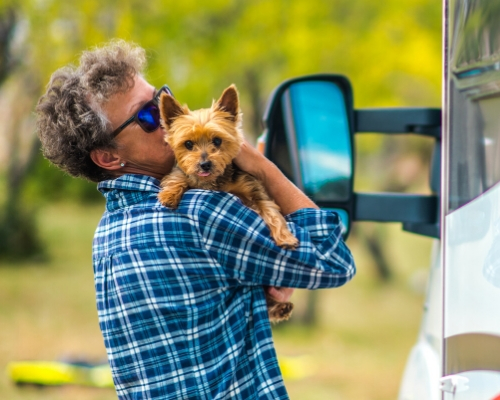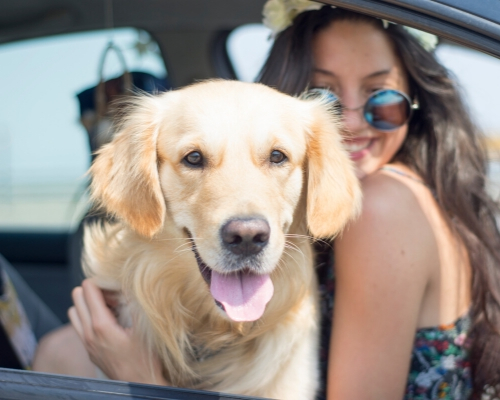Dogs are loyal companions that want to be with you everywhere you go. However, traveling with a dog at times can be a challenge.
Specific accommodations need to be made depending on the type of traveling you will be doing. If you plan on traveling with a trailer, knowing what you should and should not do when your dog travels with you is critical.
What do you need to know regarding dogs in travel trailers?
When traveling with a dog in a travel trailer, consider the following:
- Avoid having your dog ride in the trailer while it is being towed.
- Do not leave your dog unattended in a travel trailer for extended periods.
- Consider bringing some extra dog items for trailer travel that will help traveling for your dog go more smoothly.
- Have proper identification and other documents for your dog while traveling in a trailer.
- Know the health regulations and safety requirements of the states you will be traveling in.
- While on the road, regularly exercise your dog according to its age and breed.
There is much to know about dogs and traveling with them in trailers.
Continue reading to know if your dog is suited for the trip and what guidelines and recommendations you should follow to make your trip safe and enjoyable for both you and your dog.
Table of Contents
Dogs in Travel Trailers that are Being Towed
When traveling with a dog and your trailer, it is not recommended for a dog to ride in a travel trailer while it is being towed by another vehicle, whether or not the dog is in its kennel.
Travel trailers frequently bounce on the road, and items inside them get tossed around. This can be hazardous to your dog as well as terrifying.
It may be hard to get your dog to enter the trailer again after enduring a bouncy ride inside it.

If you do not have room in your vehicle for the dog and traveling with it in the trailer is your only option, there are a few things you can do to make sure the trip is as safe and comfortable as possible for your dog.
Follow these guidelines below:
- Make sure your dog is in its kennel during travel.
- Secure the kennel to the trailer, so there is no chance of it sliding or bouncing around.
- Remove all items from around the kennel that could fall on it or injure your dog in any way.
- Consider covering your dog’s kennel with a blanket or other covering for extra protection. Make sure it is still breathable for your dog.
- If possible, use something such as a baby monitor or security camera to keep an eye on your dog.
- Stop regularly to check on your dog and allow it to stretch its legs and go to the bathroom.
It is also essential to pay attention to the pet laws for the states or countries you will be in. Some countries, such as Europe, have strict laws that will not allow you to tow a dog in a travel trailer.
The United States is not as strict, so brush up on local regulations to make sure you stay on the right side of the law.
The best thing to do is always to have your dog travel in the same vehicle as you. And if there is room in your vehicle, try to keep your dog in its crate or a belted harness while you travel.
Dogs should not sit on your lap in case the ride gets bumpy, or you end up in an accident. The safest thing to do is have your dog secured just like you are.
Related reading: Do RV Rentals Allow Pets? (Pet Friendly Companies)
Can You Leave a Dog Alone in a Travel Trailer?
Whether your dog is in its kennel or not, it should not be left unattended for an extended length of time in a travel trailer while the owners are away.
Leaving your dog for short periods may be okay; however, you want to make sure the temperature of the trailer is suitable for the dog.
Be sure to check in on your dog frequently if the time away needs to be extended.
When planning to go out for the entire day, you should avoid leaving your dog in the trailer. Here is a list of concerns with leaving dogs in a travel trailer for extended periods:
- Temperature control – The temperature of the trailer needs to be adequate for your dog. When gone for an extended time, this can be hard to manage in a travel trailer.
- Malfunctions – Even if you leave the air conditioning or heat on for your dog while you are away, there is always a risk of something malfunctioning, and the power being turned off.
- Bathroom Breaks – Your dog is going to need to use the restroom at some point during the day. If you leave your dog for too long, there is a high chance you will come back to a wet or stinky mess inside the trailer or kennel.
- Barking – Some breeds of dogs may bark excessively when left unattended. This can irritate camping neighbors or even create concern in others nearby your trailer.
- Destruction – If your dog is left free to roam in your travel trailer for long enough, there is always a risk of chewing or some other form of destruction. If your dog isn’t used to living in a trailer, it will want to explore, sniff, chew, or even mark its territory on items throughout the trailer.
What to Bring for Your Dog When Traveling in a Trailer
It can be hard to remember everything you need to pack for yourself when traveling, let alone remember what your dog will need. Being well prepared for the trip will help both you and your dog have a great vacation.
Essential items to pack for your dog when traveling include:
- Dog Food and a Bowl
- Water and a Bowl
- Lease, Collar, and Tag
- Kennel
- Bed or Blanket
- Dog Shampoo and Brush
- Toys
- Cleaning Supplies
- Medications and Supplements
- Doggie Waste Bags
- Towels
- First Aid Kit
Beyond the typical things you would need for your dog while traveling.
Here are a few extra items to consider that might make the trip go a little more smoothly for you and your dog:
Have treats for your dog. You can train your dog to behave appropriately while on your trip by rewarding it with treats.
Treats can also come in handy while you are temporarily away; for example, consider purchasing a treat dispenser to provide your dog some stimulation during the day.
Bring a portable water bowl for your dog. While in a travel trailer, you will most likely be going out with your dog during the day, so bringing water with you is crucial.
Moisturizing dog shampoo. Dogs’ skin, when in nature and different climates, will get dirty and dry out easily.
Making sure you have a moisturizing or medical shampoo with you will keep your dog’s coat and skin clean and healthy.
Flea and tick repellent. Along with a good shampoo, bring something that will help keep fleas and ticks off of your dog.
Your dog does not want to be scratching itself all the time because of a pest problem on its coat, and you won’t want the dog bringing fleas or ticks into the travel trailer.
A flea and tick medication or shampoo will also help your dog avoid picking up an illness from these pests while on the road.
A pet hammock. Since you should not leave your dog in the trailer while you are towing, securing your dog in a pet hammock will be safer.
For more comfort, you can also place a pet bed in the hammock for your dog to lay on.
Pet hammocks can also keep your car cleaner and prevent any damage your dog would have caused staying directly on the seat of your car.
What Identification Do I Need for my Dog While Traveling in a Trailer?
Having the proper identification for your dog when travel can save you lots of time and headaches if your dog ends up getting lost or has a medical emergency.
It might also be a good idea to research where different veterinary offices are located along the route you will be taking just in case you need to visit one of them.

Here is a list of documents that you will want to bring along for your dog:
Vaccination records – If you need to prove at any point that your dog is up to date on its vaccines, having these records with you will come in handy.
This can also include any vaccination tags that your dog might wear.
Medical records – In case your dog needs to go to the vet because of an injury or illness, having your dog’s medical history with you will help out the doctor.
Photo of your dog – You might not think that having a picture of your dog on hand is necessary, but if your dog runs off or gets lost, having a current photo will allow you to show it to nearby neighbors or quickly make flyers or posters if necessary.
Proof of ownership – In the worst-case scenario that someone else might try to claim your dog as their own, having proof of ownership with you will keep your dog protected from being stolen.
Pro Tip: If you are worried about bringing a bunch of papers on your trip and don’t want to risk them getting lost or damaged, you can always scan the documents and put them on a flash drive or upload them to your phone.
Taking pictures will sometimes work; however, the quality at times is not the best.
Health and Safety Regulations
Each country and state has its laws and regulations on what is appropriate for travel with animals.
Depending on the animal, certain documents must be kept with you, or other health requirements must be met before travel may occur.
There will also be different safety laws on how your animal can legally travel with you on the road.
Health regulations are often established to protect the homeland’s animals from the spread of illnesses or disease from the animals passing through.
Often being up to date on your dog’s vaccinations and having those medical records with you will be all you need.
Typically, your veterinarian will be able to inform you on what vaccines and documents are required by each state you will be traveling in.
Again, depending on what state or country you will be traveling in, there will be laws established for the safety of your animal. These laws include but are not limited to:
- Sufficient room for the animal during travel
- Regulations on making sure the animal is appropriately fed
- Regulations on making sure the animal is given water regularly
- Laws dealing with proper handling of your animal
- Laws for transporting your pet in dangerous travel or weather conditions
Most of the laws listed above are established in countries outside of the United States, such as Europe.
However, even if you are planning to travel within the United States, it is a good idea to look up the laws as well as use your common sense.
Make your dog comfortable during travel with proper cushioning, such as blankets and pillows.
Also, remember that your dog should be adequately secured in the vehicle, which should have a comfortable temperature set for your dog.
Tips on Exercising Your Dog While Traveling
Most dog breeds thrive on physical activity, play, and exercise.
When traveling, long days in the car can take a toll on a dog when there is not adequate time for exercise.
Try to set aside some time to exercise your dog and give it proper restroom breaks.
Here are some tips for helping your exercise your dog while traveling:
Tip #1. Develop a schedule of when you will exercise your dog each day.
For example, when at camp, you could take your dog on a walk or run every morning and evening.
While on the road, you could make several stops throughout the drive, such as at lunch and dinner time, to exercise your dog and allow it to use the restroom.
Tip #2. Look for dog-friendly parks along your route or by your campsite that you can take your dog to occasionally.
If you happen to find some dog parks, this would be an excellent way for your dog to burn some energy as well as socialize with other dogs in the area.
Tip #3. On days that are full of bad weather, and it is challenging to get out of the trailer, play games with your dog inside the trailer if there is enough room.
Is My Dog a Travel-Friendly Breed?
Some breeds of dogs will do better on long trips compared to others.
However, just because your dog’s breed does not fit with some of the top breeds we recommend, it doesn’t mean that it won’t be a great travel companion for you.
Knowing the personality and temperament of your dog goes a long way toward knowing if it will enjoy the trip and be a good companion for you.
Here are some breeds of dogs that do well during travel:
- Jack Russel Terrier
- Yorkshire Terrier
- Labrador Retriever
- Maltese
- Chihuahua
- Havanese
- Dalmatian
- Brussels Griffon
- French Bulldog
- Pomeranian
Smaller breeds of dogs will often be easier to travel with than larger breeds, but that does not mean a larger dog shouldn’t go with you.
Here are a few things you can look for to know if your dog is suited for travel:
- Your dog is well trained, always listens, and is eager to please you.
- Your dog is friendly with other animals, children, and strangers.
- Your dog adjusts well to new environments and situations.
- Your dog has an outgoing and loving personality.
- Your dog handles changes in weather and climate well.
- Your dog likes to be with you at all times.
- Your dog adjusts quickly to new routines.
In Conclusion
Traveling with your dog is a great way to explore the world and grow closer together.
Just like any human would want to be comfortable throughout the trip, you need to make sure your dog is comfortable, as well.
To make the most of your trip, make sure your dog is safe during travel, has adequate restroom breaks, gets enough food and water, exercises regularly, and is in a suitable environment during travel.
Sources:
Recommended reading
Do RV Rentals Allow Pets? (Pet Friendly Companies)
Do RV Rentals Include Mileage? (Free Unlimited Miles)
Can You Rent an RV If You’re Under 25? [Read This Before]
Recent Posts
Is Toyota Remote Connect Free? (Subscription, Services Plans)
Does Toyota Remote Connect have an included trial? It used to be the case that, when you bought a new car, you made one straightforward payment and that was it. Now, it feels like there are...
Toyota Safety Connect: What It Is And Why You Need It? Whether you’re buying a new Toyota or you’ve had one for a while you will have been given the hard sell on their Connected Services but do...

